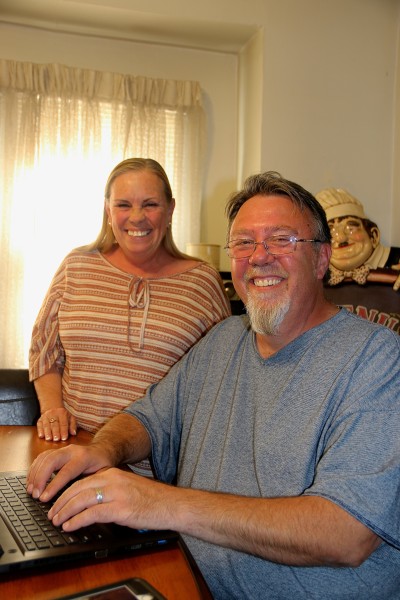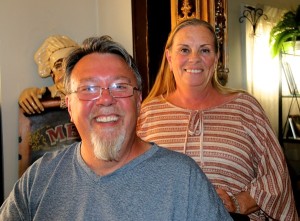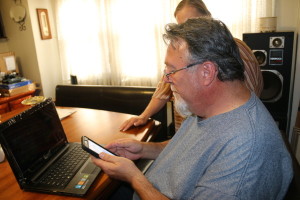
Kenny worked as a nursing home administrator for years and then his life was forever altered when he had a stroke in 2012. As a result of the stroke, he lost his vision in both eyes. He also lost hearing in both ears. He has 20% hearing in his left ear and 70% in his right and now wears hearing aids.
When Kenny had his stroke he continued to work for 8 months, but his health condition got worse. After losing his job and several years of frustration in trying to find help, he was finally told he should open up a case with Vocational Rehabilitation (VR). VR is a state agency that provides services to people with disabilities to “prepare for, obtain or retain employment”.
Once he was involved with VR, he then started to get some of the help he so desperately needed. He worked with an Orientation and Mobility (O&M) instructor to learn how to use a white cane, how to get around the house, how to use the bus system, and how to use escalators and stairs. He now feels comfortable getting around his home and directly outside his home and can even get around the block independently. He will be getting a guide dog in November and looks forward to even greater independence. After receiving O&M Training, he was then referred to Easter Seals Crossroads for an assistive technology evaluation to assess his other needs.
I met with Kenny to learn what his experience was like in working with our Assistive Technology department. He indicated that he had been terribly depressed before meeting with our Assistive Technology Specialist, Belva Smith. He indicated that he would panic at the thought of having to leave his home. His biggest fear was falling after he had fallen down his basement stairs. He says that second to those fears was a feeling of deep frustration over not being able to communicate. Kenny indicated he felt very isolated and he felt really frustrated that he couldn’t even read his mail. Kenny worked with Belva to determine his accommodation needs. Kenny was not ready to seek employment at the time of those recommendations so VR could not pay for the accommodations that would help Kenny become more independent.
Belva then let him know about the iCanConnect program. The iCanConnect program is designed to help anyone who has both vision and hearing loss and meets federal income guidelines. If an individual meets their guidelines, they can provide them with free communication technology.
Belva educated Kenny about a software program called JAWS, Job Access With Speech, and told him about all the accessibility features of an iPhone and great apps like the KNFB reader. JAWS is a screen reader that provides speech and Braille output for your computer. The KNFB reader makes printed material accessible by using a camera to capture and read documents. Kenny was so thrilled to learn that he would be able to read his mail and his prescription labels. He indicated that he felt really lost before meeting Belva and “didn’t realize there was anything like that out there”. Through the iCanConnect program he received a computer with JAWS and an iPhone, which he then purchased the KNFB reader app.
 When Kenny spoke about Belva, I was humbled at the reverence and appreciation he had for her and what he says, “changed his life”. He indicated she was the first person who had answers and had given him hope. He told me he could not believe he was reading his mail and was starting to feel hopeful about getting out of his house more and hopefully become gainfully employed down the road.
When Kenny spoke about Belva, I was humbled at the reverence and appreciation he had for her and what he says, “changed his life”. He indicated she was the first person who had answers and had given him hope. He told me he could not believe he was reading his mail and was starting to feel hopeful about getting out of his house more and hopefully become gainfully employed down the road.
He spoke of his great frustration of being shuffled around with every call he made when he was trying to find help. He indicated that what was most helpful is having Belva come into his environment to learn what he was struggling with instead of just making assumptions and recommendations. He wishes all providers working with people with disabilities would think about how desperate someone may be when they call and to think about who can help them if they can not and not leave people on a dead end street.
Kenny’s infectious smile lights up a room when he talks about being able to use a computer. He had indicated that he did not even consider using a computer and had no idea that he would be able to one day. He shares with me that “I went for so long with all that frustration and then all it took was one visit with Belva and she took care of my problems”. Belva and Kenny discussed how his attitude has completely changed for the better. Belva said, “this isn’t the same man I met the first time I met him” in which Kenny responded, “If it hadn’t been for her, I wouldn’t have anything”. I asked Kenny what his advice would be to anyone that finds themselves in a similar situation and he quickly responded, “I would tell them to just call Belva. She’ll have an answer”.
Kenny is now using a computer with JAWS, an iPhone and an app called KNFB  reader. He indicates that it eliminated so many of his communication difficulties. He uses Siri on his phone to make appointments, make calls, record notes at his doctor appointments, and so much more. He is thrilled to be able to use the KNFB reader to help his 10-year-old son do homework and by the end of the time we spent together, he was teaching Belva and myself some new tricks on the iPhone.
reader. He indicates that it eliminated so many of his communication difficulties. He uses Siri on his phone to make appointments, make calls, record notes at his doctor appointments, and so much more. He is thrilled to be able to use the KNFB reader to help his 10-year-old son do homework and by the end of the time we spent together, he was teaching Belva and myself some new tricks on the iPhone.
Kenny is looking forward to even greater independence. He hopes that once he gets his guide dog he will feel more comfortable leaving his home. He tells us he would love to work, but does not want to be dependent on someone to take him to work. He hopes he will become independent enough with his guide dog to use the bus system to get back into the work force and feel more comfortable outside of his home. Kenny is quite sharp and has a really great personality. Equipped with those traits, a Master’s Degree, years of experience, and assistive technology; it’s my humble opinion that Kenny would be a great asset to any organization. I am looking forward to hearing updates about Kenny and it is the hope of the three of us that his story may touch you or someone you know and give them the knowledge and hope they may desperately be seeking.
